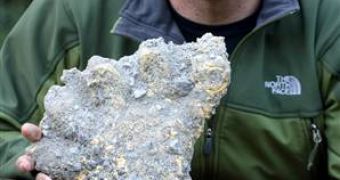Yeti, also called the "abominable snowman", represents the most fascinating legend of the Himalaya. Stories tell about a huge ape-like creature, bipedal (walking on two feet), with small ears and long red hair. And the stories do not originate from the territory of Himalaya, but they also come from the mountains of southwestern China.
Moreover, unlike Big Foot or Chupacabra, Yeti has a palaeontological record: Gigantopithecus, the largest ape ever, which lived 5 million to 100,000 years ago in about the same areas: it was 3 m (10 ft) tall and weighed 300-500 kg (660 to 1100 pounds) (matching the descriptions of Yeti). It had a gorilla-like lifestyle, and its diet could have been based on bamboo. Gigantopithecus's closest relative is the orangutan (the modern apes have red hair too...).
No one has ever managed to take a picture of Yeti. But now, a foot print found by an American TV crew and presented on Sunday could strengthen the local stories and also the belief that the mythical (or not) giant ape still roams on Mount Everest.
The team of Josh Gates, the host of Sci Fi's "Destination Truth", traveled to Himalaya and discovered three footprints on 28th of November, while searching for proof of Yeti's existence in a remote Khumbu region, on the bank of the Manju River, at an altitude of 9,350 feet (2,850 meters), where Sherpas and farmers had recently sighted the creature.
"One print was clearly from a right foot with five toes, and was about 13 inches (33 cm) long, but the other two were only partial prints. The footprints were found on rock and sand, and were relatively fresh, left some 24 hours before we found them." said Gates.
"The TV crew planned to have the castings analyzed in the United States. We are excited about what we found," he said. Not everybody is convinced about the findings.
"It could most likely be footprints of the mountain bear which is found in the area. They showed five toes in the footprint cast they brought back, but according to the legends we hear from the villagers the yeti is only supposed to have four toes." said Ang Tshering, president of the Nepal Mountaineering Association, a native of Khumbu.
"I don't believe it to be a bear. It is something of a mystery for us." Gates told Reuters.
And in fact, the prints do not prove the existence of Yeti 100 %.
"The unfortunate thing about footprint castings is that they are rarely conclusive," admitted Gates.
"There is a mysterious animal that exists in this region but that does not necessarily mean it is a yeti. It is still hard to say if this is a myth or reality." said Thsering.

 14 DAY TRIAL //
14 DAY TRIAL // 
